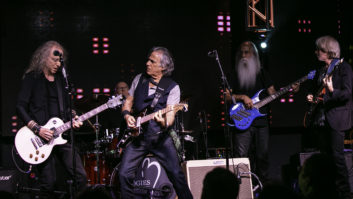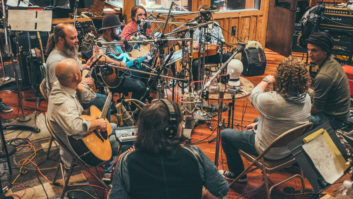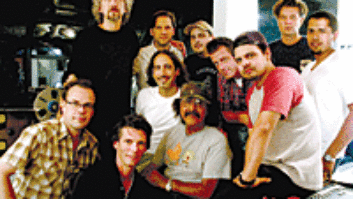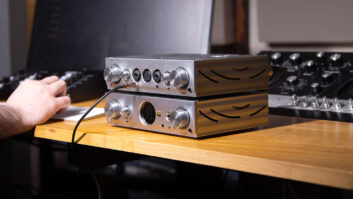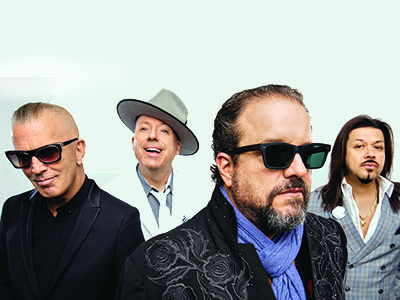
Niko Bolas points out the big difference between casting musicians to support a solo artist and working with a band like The Mavericks. “Both can be fun,” he says, “but think about the big bands: In the ’40s, you had 35 guys on a bus jamming, 24 hours a day. No wonder they were so good. With the Mavericks, they do the show, they go to the dressing room, they get on a bus, they tell the same jokes, they get up the next day, they have breakfast, they hit another stage. Their communication is second to none. You get the sound of a band.”
The Mavericks’ latest release, Brand New Day, is the third album Bolas has engineered and co-produced for the group, after meeting frontman Raul Malo in 2009. “I did a record for Lorrie Morgan; we did 40 pieces live in Nashville, and Raul showed up to sing a duet with her, and I was blown away,” he recalls. “Mary Hogan at Concord, who I’ve been friends with forever, said, ‘He’s signed to Concord. You guys should meet.’ We met up later at The Village; he was doing some prep on a record where he’d sung live with the London Philharmonic, and Mary wanted me to mix it.”
When The Mavericks made In Time (Big Machine, 2013), their first album together after a ten-year hiatus, Malo asked Bolas to mix again. “I told him, ‘No,’” Bolas says. “‘I’ll only mix it if I can record it.’ If you’re just mixing, it’s already happened. The way I learned to make records—three years with Val Garay—the day you cut it is the day you’re really mixing it. It all happens on their side of the window. If I can do that with a band, that’s the greatest fun in the world. So I flew to Nashville, and we started.”
In Time and the follow-up, Mono, were both Top 10 country records, and today’s Mavericks—including founders Malo and drummer Paul Deakin, and longtime members Eddie Perez (guitars) and Jerry Dale McFadden (keyboards)—have been touring nonstop, enjoying a new round of success with the Latin-meets-country band that originally formed in Miami in 1989. In 2016, the band released a concert album, All Night Live, Vol. 1—the first record on their own Mono Mundo label. When it came time to go into the studio to track Brand New Day, they had to carve out time between tour dates.

Niko Bolas and Raul Malo in Blackbird Studio A.
Photo: James O’Mara
The album started in Nashville, in Blackbird Studio A. “It’s just the best in the world to record a band like The Mavericks, because you can do everything live, including vocals,” Bolas says. “Everything works, the line of sight is fantastic, the headphones are great, and everything you need—they have three of them.
“I’ll often tell John [McBride, studio owner], ‘The only things you have only one of are things that there is only one of. And that goes for instruments as well as microphones. So if you have a whimsical idea and you want tubular bells, they have some. They’re in storage right behind the second building.”
To set up the date, Bolas went in the night before with a few interns and his assistant, Sean Badum, who “will know how to set everything up because we’ve done several records together,” Bolas explains.” Most of the interns are musicians, and we’ll have them go out and jam on the instruments. In 30 minutes, we know all the mics are working and we have a balance.”
The bandmembers’ stations were arranged in a circle to ease communication. Bolas put up a Telefunken 251 for Malo, sent through the classic Neve 8078 console and either an LA2A or a Fairchild compressor/limiter. On keyboards—grand piano, B-3 and Wurlitzer—the engineer/producer says he sometimes used Sennheiser 421 on the low end and an AKG 452 on the high end, but more often he employed one or two 251s.
“I love mono pianos, so sometimes it’s just one 251,” he says. “But the real secret to the sound is to have Jerry Dale play it, move your head around until you hear everything, and put the microphone there.”
On guitars, Bolas hangs another 251 about a foot away from Perez’s cabinet. “You have to understand that part of the fun if you’re at Blackbird is, you can use 251s on everything. I don’t use equalizers. I just run that microphone to the Neve console, and then if we want it brighter, we move the microphone.”
On Deakin’s kit, Bolas says, “It’s just three mics, the way I learned from Glyn [Johns]: 421s or 57s. But again, you’re only as good as what’s in front of the microphone. I’ve said this to people before: If I put Steve Jordan in my closet with a Shure 57 and he’s in a good mood, it’s going to be a good drum sound, and everybody’s going to want to know the dimensions of my closet. But they’ve missed the point.”
(Note: The Mavericks’ longtime bassis,t Robert Reynolds, departed the band in 2015; electric and upright on this album were covered by Ed Friedland.)
On session days, Bolas says, “We’ll have our coffee, hang out in the control room with a turntable, and play whatever vinyl they’re into. We listen to old records, talk about the arrangement of the first tune, and go out and cut it.”
Old records played an influential role in the sound of Brand New Day. A morning spent listening to Phil Spector productions, for example, inspired the sound of the title track.
“That track is damn near mono, and we put everything on that thing, including kettle drums and those tubular bells,” Bolas says. “Deakin added tympani and a glockenspiel—all the things we heard on the vinyl we played that morning. It kept evolving until we realized, it’s the Wall of Sound! Something I’ve learned over the years is, it’s always easier to play an idea than it is to talk about it.”

Legendary engineer Al Schmitt stopped in during sessions in Capitol Studio A.
Photo: Cathryn Farnsworth
Tour dates took the band away from Blackbird, but they were able to carve out time while they were all in L.A. Bolas booked Studio A at Capitol, where he says they had a great time maximizing the room sound. The band also tried out some new microphones, as Dusty Wakeman of Mojave asked Bolas to field-test some new models.
“Dusty is an old-school engineer buddy of mine,” Bolas says. “We did some songs, and I gave them a review of all the mics we used. I think the biggest winner was the M1000, which we used on Raul’s vocal. It went through two sets of changes, and I think it really went from decent to excellent, to where Raul wants to buy one.”
Bolas final-mixed the album in his studio, The Surf Shack (Ventura, Calif.), which is equipped with Pro Tools and ATC50 speakers. However, he’s quick to point out that the great energy and rich sounds of the album really come from the rough mixes he worked up after live sessions.
“Most of the mixes started their life at the end of a session at Blackbird,” he emphasizes. “I consider everybody’s notes, and we’ll overdub or make changes if we don’t like a part, but the rule is, ‘Don’t lose sight of what you fell in love with on the day.’ Turn the speakers up loud, and if it feels good, print it.”
